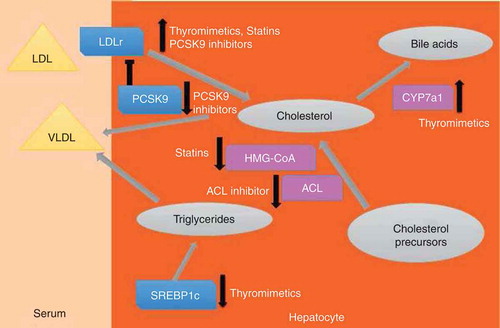Figures & data
Figure 1. Schematic: Influences of cholesterol-lowering therapeutics on hepatic and extrahepatic cholesterol metabolism. The figure is a simplified depiction of cholesterol metabolism and flux in hepatocytes. Gray circles represent metabolites, rectangles represent proteins (purple = enzymes, blue = other proteins), triangles represent lipoprotein particles. Large pale gray arrows represent directions of cholesterol flux and metabolism. Small arrows at side of proteins represent changes in activity, either through alterations in protein levels or enzyme activity. Thyromimetics enhance low-density lipoprotein receptor (LDLR) expression, increase cholesterol to bile acid conversion by inducing expression of the cholesterol-processing enzyme cholesterol 7α-hydroxylase (Cyp7A1) and inhibit expression of the transcription factor sterol response element-binding protein (SREBP1c), which directs genes involved in triglyceride (TG) synthesis. Statins inhibit HMG-Co reductase with secondary effects on LDLR expression. Proprotein convertase subtilisin/kexin type 9 (PCSK9) inhibitors block PCSK9-dependent degradation of LDLR, thereby increasing LDLR levels. The ATP citrate lyase (ACL) inhibitor blocks cholesterol synthesis.

Table 1. Comparison of actions of sobetirome and eprotirome.
